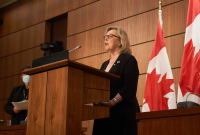Support strong Canadian climate journalism for 2025
With continuing controversy over the federal government’s fossil fuel subsidies, provinces' climate and emission plans are also being scrutinized. And now that the Ontario election campaign is in full swing, both candidates and voters are turning their attention to roads and transportation with an environmental health lens.
Bonnie worked for over 35 years at the Ambassador Bridge in Windsor, Ont. Reflecting on her breast cancer diagnosis, she said: "The environment, I have no control over that, other than quitting [my job]. But the air that we breathe, I don't feel like I have any control over that at all."
(Bonnie and the other women quoted in this piece, spoke candidly with us on the condition we did not publish their full names.)
The Ambassador Bridge, the busiest border crossing in North America, is an environment with heavy traffic-related air pollution (TRAP) from diesel trucks and other vehicles. Nearby residents and workers at the bridge report high levels of breast and other cancers, among other health problems linked to TRAP.
Bonnie's words reflect a critical problem for people's health in Canada and across the globe: a lack of control over exposure to air pollutants in the spaces where we live, work, play and grow.
Hard evidence of ill health
Released just after the UN health agency's statement that nearly everybody in the world breathes air that doesn't meet its air-quality standards, the Canadian Association of Physicians for the Environment’s (CAPE) new research report, Mobilizing Evidence: Activating change on traffic-related air pollution (TRAP) health impacts, brings together hard evidence of the need to clean the air for health promotion, illness prevention and environmental justice.
Based on the data from a scoping review of the scientific literature, the report summarizes nearly 1,200 papers. The evidence demonstrates environmentally driven health impacts and disparities arising from TRAP exposure.
Dana, an Ambassador Bridge worker, says, "When you think about what you are actually breathing in, you wonder, 'How does that affect your health?' A lot of our toll collectors have cancer of some sort as they've gotten older." Answers to Dana's question are found in the research synthesized in the report.
Scientific evidence points to causal associations between traffic-related air pollution exposure and reduced lung function, asthma incidence and prevalence in children and adults, and allergic sensitization and response. TRAP exposure is also linked to respiratory diseases such as chronic obstructive pulmonary disease and bronchitis; cardiovascular diseases and myocardial infarction; neurological impacts, declines, diseases, as well as neurodevelopmental effects and delays; pregnancy-related outcomes, including congenital abnormalities, infertility, and eclampsia; cancers, importantly lung cancer, leukemia, and breast cancer; diabetes; obesity; dermatological outcomes; and mental health-related outcomes such as anxiety and depression, noise-related stress, insomnia and sleep disturbance. TRAP exposure is also expressed in elevated mortality rates.
Addressing exposures and inequities
TRAP and environmental inequality are also related. The associated health risks are disproportionately experienced in communities with higher levels of TRAP, sometimes also communities where racialized, Indigenous and poor people live. Research also shows that air pollution increases COVID-19 infection, transmission and the risk of COVID-19-related mortality.
CAPE's report highlights the opportunity to reduce air pollution's health harms and improve community well-being. The recommendations provided begin to outline how we can control exposures for human and planetary health. Ranging from structural to individual-level actions, the recommendations include:
- adopting pollution prevention and control policies that address fuel content and vehicle-type requirements, restrictions on idling, low-emission zones, and the use of public transit and electric vehicles;
- increasing active transport infrastructures, such as cycling networks and cycling mode shares;
- mandating proper air filtration and ventilation in indoor residential, public and community gathering spaces;
- expanding urban green space and vegetation barriers in high-traffic areas; and
- using individual-level actions, including the use of personal protective equipment and increasing dietary antioxidant intake.
As the evidence reveals, TRAP and the adverse health impacts are a design problem. To prevent illness and death related to air pollution in communities in Canada and across the globe, we need to implement, enforce and extend policies that prevent TRAP and the associated illnesses.
Jackie from the bridge asserts: "There is a definite obligation to make sure people are in a healthy and safe environment." Individual control over environmental exposures, health risks, and outcomes is not always possible. The legal right to a healthy environment and environmental justice is fundamental as we work towards a future of improved environmental and human health.






Comments